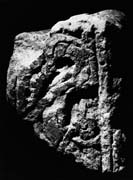Select a site alphabetically from the choices shown in the box below. Alternatively, browse sculptural examples using the Forward/Back buttons.
Chapters for this volume, along with copies of original in-text images, are available here.
Object type: Part of cross-shaft [1]
Measurements: H. 32.7 cm (12.9 in); W. 22.7 > 19.5 cm (9 > 7.7 in); D. 17.5 cm (6.9 in)
Stone type: Fine-grained, calcareous, very pale brown (10YR 8/4) sandstone; probably Middle Calcareous Grit, Coralline Oolite Formation, Middle Oxfordian, Upper Jurassic; possibly local
Plate numbers in printed volume: 751-754
Corpus volume reference: Vol 3 p. 199
(There may be more views or larger images available for this item. Click on the thumbnail image to view.)
A (broad): The edge moulding is flat and double. Within the panel is an S-shaped profile ribbon beast with double outline. Its small head has an incised oval eye and the jaws gape. The contoured edge on its back divides behind the extended ear to form a fetter across the neck. The tail is small and coiled, forming a tangent from the rump's contour. The hind leg's ankle is fettered by a narrow strand; its foot has three toes. There are traces of a panel moulding by the rump.
B (narrow): This face is much worn. There is a double flat edge moulding. Within the panel is part of a ring-twist, with two free rings and the start of a third, and a bar terminal at the lower end. The strands are broad and flat. The strand appears to override the frame at one point.
C (broad): The double flat edge moulding continues across the broken base of the fragment. The panel, which tapers pronouncedly, is filled with interlace: a simple pattern F unit (Carrick Bend), with a bar terminal below. The strands are flat and median-incised.
D (narrow): The double flat edge moulding contains interlace, using median-incised strands: a bar terminal at the top, below which is a unit of simple pattern F (Carrick Bend).
The small, tapering shaft is most closely paralleled by the Nunnington fragments (Ills. 699–708). There is evidence that the fragment is relatively complete in its ornamental panels, so it may have been a stumpy grave-marker, or an element from a composite shaft. The ornamental repertoire is typical of the area, and the small beast should be compared with those at Ellerburn 1 (Ill. 427), and Nunnington 1–2. It is in the 'Ryedale bound dragon' tradition but probably a reflex of the Sinnington group. The ring-twist is typical of Anglo-Scandinavian taste in the eastern half of Yorkshire.



